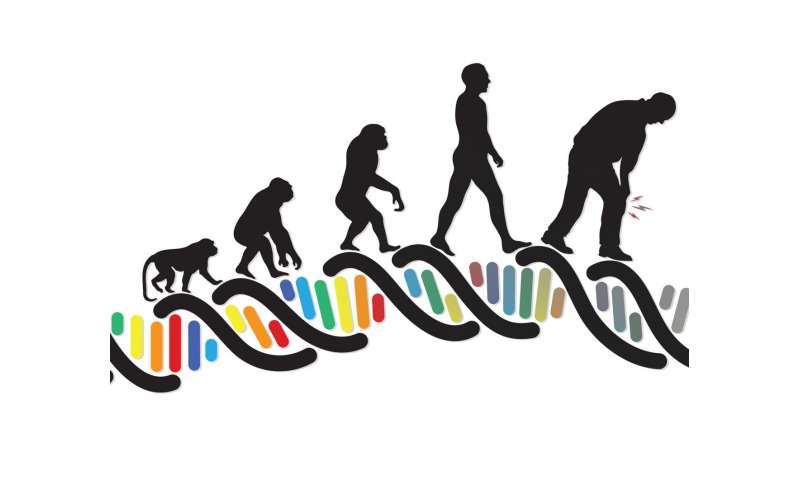https://medicalxpress.com/news/2020-04-evolutionary-links-subtle-modifications-morphology.html

The human knee is a triumph of design. The joint, which evolved fairly rapidly from our common ancestor with the chimpanzee to accommodate our bipedalism, likely contributed to our success as a species. However, as modern medicine extends the human lifespan, our species have learned pain in the form of osteoarthritis that can accompany the locomotion of this biomechanical masterpiece.
In a new study of the genetic features that help make this sophisticated joint possible, an international team of researchers found that the regulatory switches involved in the development of the knee also play a role in osteoarthritis, a partially heritable disease that afflicts at least 250 million people worldwide. The findings are published in the journal Cell.
Terence D. Capellini, Richard B. Wolf Associate Professor in the Department of Human Evolutionary Biology and the paper's corresponding author, explained it in terms of the burden our knees literally endure:
more at link......
the paper:
https://www.cell.com/cell/fulltext/...m/retrieve/pii/S0092867420302348?showall=true
Summary
During human evolution, the knee adapted to the biomechanical demands of bipedalism by altering chondrocyte developmental programs. This adaptive process was likely not without deleterious consequences to health. Today, osteoarthritis occurs in 250 million people, with risk variants enriched in non-coding sequences near chondrocyte genes, loci that likely became optimized during knee evolution. We explore this relationship by epigenetically profiling joint chondrocytes, revealing ancient selection and recent constraint and drift on knee regulatory elements, which also overlap osteoarthritis variants that contribute to disease heritability by tending to modify constrained functional sequence. We propose a model whereby genetic violations to regulatory constraint, tolerated during knee development, lead to adult pathology. In support, we discover a causal enhancer variant (rs6060369) present in billions of people at a risk locus (GDF5- UQCC1), showing how it impacts mouse knee-shape and osteoarthritis. Overall, our methods link an evolutionarily novel aspect of human anatomy to its pathogenesis.


The human knee is a triumph of design. The joint, which evolved fairly rapidly from our common ancestor with the chimpanzee to accommodate our bipedalism, likely contributed to our success as a species. However, as modern medicine extends the human lifespan, our species have learned pain in the form of osteoarthritis that can accompany the locomotion of this biomechanical masterpiece.
In a new study of the genetic features that help make this sophisticated joint possible, an international team of researchers found that the regulatory switches involved in the development of the knee also play a role in osteoarthritis, a partially heritable disease that afflicts at least 250 million people worldwide. The findings are published in the journal Cell.
Terence D. Capellini, Richard B. Wolf Associate Professor in the Department of Human Evolutionary Biology and the paper's corresponding author, explained it in terms of the burden our knees literally endure:
more at link......
the paper:
https://www.cell.com/cell/fulltext/...m/retrieve/pii/S0092867420302348?showall=true
Summary
During human evolution, the knee adapted to the biomechanical demands of bipedalism by altering chondrocyte developmental programs. This adaptive process was likely not without deleterious consequences to health. Today, osteoarthritis occurs in 250 million people, with risk variants enriched in non-coding sequences near chondrocyte genes, loci that likely became optimized during knee evolution. We explore this relationship by epigenetically profiling joint chondrocytes, revealing ancient selection and recent constraint and drift on knee regulatory elements, which also overlap osteoarthritis variants that contribute to disease heritability by tending to modify constrained functional sequence. We propose a model whereby genetic violations to regulatory constraint, tolerated during knee development, lead to adult pathology. In support, we discover a causal enhancer variant (rs6060369) present in billions of people at a risk locus (GDF5- UQCC1), showing how it impacts mouse knee-shape and osteoarthritis. Overall, our methods link an evolutionarily novel aspect of human anatomy to its pathogenesis.

